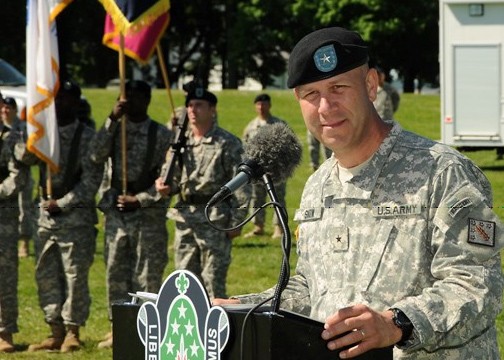ABERDEEN PROVING GROUND, Md. - Brig. Gen. Jeffrey J. Snow relinquished command of the U.S. Army 20th Support Command CBRNE (Chemical, Biological, Radiological, Nuclear and High Yield Explosives) during a colorful May 7 ceremony here on McBride Parade Field.
Nearly 250 people - dignitaries, family, friends and 20th Support Command Soldiers and Civilians - listened as Gen. Charles C. Campbell, commander, U.S. Army Forces Command, listed Snow's achievements and accepted the organizational colors to symbolize the transfer of leadership.
Campbell commended Snow for his extraordinary leadership.
"The 20th SUPCOM is an indispensable asset to the fight. It is a national treasure. Just as the units and capabilities of the 20th SUPCOM are special, so also is its commander," Campbell said.
Snow said the opportunity to lead for the past 22 months had been a privilege. He commanded 20th SUPCOM since July 2008.
"I am leaving here as a better commander because of the Soldiers and Civilians of the 20th SUPCOM. I am incredibly humbled and proud of what each of you do each and every day in support of our Army," Snow said.
Snow will soon assume duties as director of the Iraq Training and Advisory Team-Army, U.S. Forces-Iraq.
Brig. Gen. Leslie C. Smith, commandant, U.S. Army Chemical, Biological, Radiological and Nuclear School and deputy commanding general, Material and Technology, U.S. Army Maneuver Support Center of Excellence, Fort Leonard Wood, Mo., has been selected to be the next 20th SUPCOM commander. He will assume his new duties July 8.
Col. Thomas Cartledge, the current chief of staff of the organization, will serve as interim commander.
The 20th Support Command, also called the CBRNE Command, was activated Oct. 16, 2004, by U.S. Army Forces Command to provide specialized CBRNE response in support of military operations and civil authorities.
The 20th SUPCOM (CBRNE) gives the Army and the nation a flexible response capability to operate in a variety of environments, from urban areas to austere sites across the spectrum of military operations. CBRNE operations detect, identify, assess, render safe, dismantle, transfer, and dispose of unexploded ordnance (UXO), improvised explosive devices (IED) and other CBRNE hazards. These operations also include decontaminating personnel and property exposed to CBRNE materials during response.


Social Sharing